Zoom
Trash

How to Write Guide: Sections of the Paper. | Table of Contents | FAQs | PDF Version | | Rationale | Sections | Section Headings | Title | Authors and Affiliation | Abstract| Introduction| Methods| Results| Discussion | Acknowledgments| Literature Cited | Appendices Why a Scientific Format?
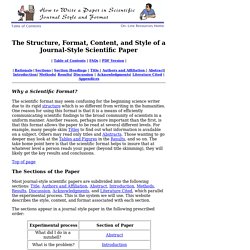
The scientific format may seem confusing for the beginning science writer due to its rigid structure which is so different from writing in the humanities. One reason for using this format is that it is a means of efficiently communicating scientific findings to the broad community of scientists in a uniform manner. Another reason, perhaps more important than the first, is that this format allows the paper to be read at several different levels. For example, many people skim Titles to find out what information is available on a subject.
The Coordinating Conjunction. Use a coordinating conjunction when you want to give equal emphasis to two main clauses.

Modality. Character Development. Text World Theory. Tolkien. Tolkien 2. Cognitive stylistics. Stylistics. Repetition. Literary memories of World War One. First World War Literature. The 1939 war had barely completed its second year when writer Robert Graves began an article in The Listener, 'I have been asked to explain as a "war poet of the last war" why so little poetry has so far been produced by this one'.
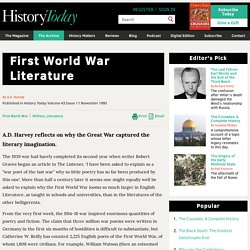
More than half a century later it seems one might equally well be asked to explain why the First World War looms so much larger in English Literature, as taught in schools and universities, than in the literatures of the other belligerents. From the very first week, the 1914-18 war inspired enormous quantities of poetry and fiction. The claim that three million war poems were written in Germany in the first six months of hostilities is difficult to substantiate, but Catherine W.
Why literature written out of the First World War is some of the last century’s finest writing. I do not rush to read books about war; in fact, I avoid them.
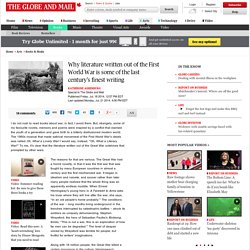
But, strangely, some of my favourite novels, memoirs and poems were inspired by a conflict that claimed the youth of a generation and gave birth to a bitterly disillusioned modern world. World War I in literature. General[edit] The spread of education in Britain in the decades leading up to World War It meant that both the British soldiers and the British public, at all levels of society, were literate.

As a result, British authors, both professional and amateur, were prolific during and after the war and found a market for their works.[1] Authors Who Turned Wartime Experiences into Literature. Search ThaiLIS Digital Collection. QUALITATIVE RESEARCH. Beginning Research | Action Research | Case Study | Interviews | Observation Techniques | Education Research in the Postmodern Evaluation Research in Education | Narrative| Presentations | Qualitative Research | Quantitative Methods | Questionnaires | Writing up Research Originally prepared by Professor Peter Woods.
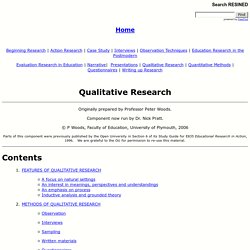
Component now run by Dr. Nick Pratt. © P Woods, Faculty of Education, University of Plymouth, 2006 Parts of this component were previously published by the Open University in Section 6 of its Study Guide for E835 Educational Research in Action, 1996. How to structure quantitative research questions. STEP TWO Identify the different types of variable you are trying to measure, manipulate and/or control, as well as any groups you may be interested in Whether you are trying to create a descriptive, comparative or relationship-based research question, you will need to identify the different types of variable that you are trying to measure, manipulate and/or control.
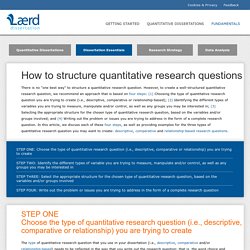
If you are unfamiliar with the different types of variable that may be part of your study, the article, Types of variable, should get you up to speed. It explains the two main types of variables: categorical variables (i.e., nominal, dichotomous and ordinal variables) and continuous variables (i.e., interval and ratio variables). Hemingway on War and Its Aftermath. Hemingway used this 1923 passport for his return to Europe, where he initially worked as a correspondent for the Toronto Star.

(Ernest Hemingway Photograph Collection, Kennedy Library) Hemingway and Kennedy: What's the Connection? When Mary Hemingway, Ernest Hemingway's widow, chose to give her late husband's papers to the John F. Kennedy Presidential Library, she did so as a gift to Hemingway scholars and readers around the world. When Ernest Hemingway died in 1961, a large portion of his literary and personal estate remained at the Finca Vigia, his home in Cuba where he and Mary lived before Castro's revolution.
เทคนิคการเขียนวิทยานิพนธ์ตอนที่ 2: ระเบียบวิธีวิจัย Research Methodology Chapter in MSc Dissertation (UK) เกร็ดการทำวิจัยตอนที่ 32: การเขียน Proposal. Linguist List - Reviews Available for the Book. Review's Editor: Helen Aristar-Dry Edited by Michael Burke, “The Routledge Handbook of Stylistics” (henceforth, RHS) introduces key concepts within stylistics and is aimed at anyone with an interest in literature, language, or culture.
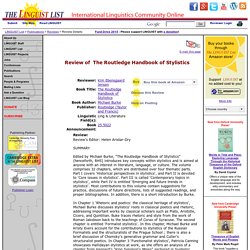
The volume comprises 32 chapters, which are distributed over four thematic parts. Part I covers 'Historical perspectives in stylistics', and Part II is devoted to 'Core issues in stylistics'. Part III is called 'Contemporary topics in stylistics', while Part IV is entitled 'Emerging and future trends in stylistics'. Most contributions to this volume contain suggestions for practice, discussions of future directions, lists of suggested readings, and proper bibliographies.
In Chapter 1 'Rhetoric and poetics: the classical heritage of stylistics', Michael Burke discusses stylistics' roots in classical poetics and rhetoric, addressing important works by classical scholars such as Plato, Aristotle, Cicero, and Quintilian. Deixis. Person deixis, place deixis and time deixis Types of deixis[edit] Traditional categories[edit] Possibly the most common categories of contextual information referred to by deixis are those of person, place, and time - what Fillmore calls the “major grammaticalized types” of deixis.[4] Person[edit] Person deixis concerns itself with the grammatical persons involved in an utterance, (1) those directly involved (e.g. the speaker, the addressee), (2) those not directly involved (e.g. overhearers—those who hear the utterance but who are not being directly addressed), and (3) those mentioned in the utterance.[5] In English, the distinctions are generally indicated by pronouns.
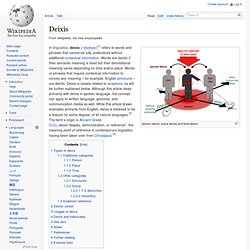
Writing a Bibliography: APA Format. Please ensure you have JavaScript enabled in your browser. If you leave JavaScript disabled, you will only access a portion of the content we are providing. <a href="/science-fair-projects/javascript_help.php">Here's how. </a> Below are standard formats and examples for basic bibliographic information recommended by the American Psychological Association (APA). English studies. APA Formatting and Style Guide. Note: This page reflects the latest version of the APA Publication Manual (i.e., APA 7), which released in October 2019. The equivalent resource for the older APA 6 style can be found here. Reference citations in text are covered on pages 261-268 of the Publication Manual. What follows are some general guidelines for referring to the works of others in your essay. Examples of Personification. Everyone knows what a person is, but do you know what personification is?
Personification is when you assign the qualities of a person to something that isn't human or, in some cases, to something that isn't even alive. Personification. Personification is a literary device in which human attributes and qualities are given to nonhuman or inanimate objects. For example, a sentence may say, “the old hardwood floor groaned under the weight of the heavy table.” In this sentence, the hardwood floor is personified, being given the ability to groan like a human. The reader understands this to mean that the floor made a creaking noise when the heavy table was placed upon it. By using personification and giving the floor human-like attributes, the sentence resonates more with the reader, offering a better image of what is happening. Writers use personification to help to establish mood and to build imagery in a piece of writing. Personification also helps to boost emotion and can make plain sentences more interesting when used effectively.
Useful Words in Custom Academic Writing. Useful Words for writing essays/term papers/research papers The first and foremost step of writing a report, an essay or an article is the selection and usage of appropriate words at the appropriate places. 70 useful sentences for academic writing. How to Use English Punctuation Correctly (with Examples) Steps.